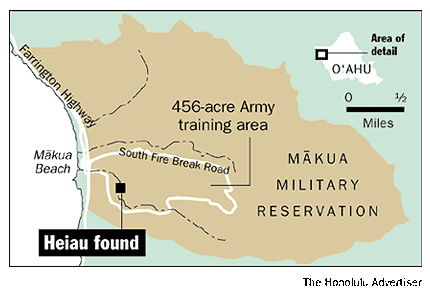
By Mike Gordon
Advertiser Staff Writer
Centuries-old Hawaiian settlements have been found within the boundaries of the Army’s live-ammunition training site in Makua Valley, raising further concerns in the community about continued military training there.
The six archaeological sites include the remains of a heiau, or Hawaiian shrine, and several imu, or underground ovens. They were discovered during a survey for the Army that was conducted by Ogden Environmental & Energy Services Co. and recently obtained by a community group opposed to the use of Makua Valley for training.
In each case, Ogden recommends protection and preservation of the sites, which the survey notes has "revealed important new information" about the Hawaiians who lived in Makua prior to the arrival of Westerners. It said the sites suggest a substantial population once lived there.
The Army has nearly finished a study of the valley. It is moving ahead with the public comment phase of a supplemental environmental assessment of training in Makua and says live-ammunition exercises, which were suspended in September 1998, could resume as early as March.
Leeward Coast residents, whose anger about military use of the valley has simmered for years, have grown increasingly vocal in recent weeks about the Army’s plans to resume using the valley.
But after the December publication of the assessment, the community has threatened occupation of the valley, filed suit in federal court to stop further training and questioned the health impacts of hazardous materials used or disposed of in Makua. A large, and possibly bitter, crowd is expected to attend the Army’s Jan. 17 public hearing in Wai‘anae.
The Ogden survey was completed in May, but was not included in the Army’s environmental assessment released in December, although it was noted in a bibliography included in that report. The survey did not arrive in Army offices until November, said Laurie Lucking, cultural resources manager for the 25th Infantry Division (Light) and U.S. Army Hawaii.
"There is no attempt to hide anything," said Lucking, who has not read the survey. "I received this well after the draft environmental assessment had been completed, no matter what the date says. We added it to the bibliography and the additional sites to a table."
The draft environmental assessment was completed last September and the final version presented to the community on Dec. 14.
The Ogden survey said Makua Valley, instead of being a dry valley with a coastal population, may have had enough water resources to support two large villages in the middle elevations that included agriculture, permanent habitation, burials and religious activities. They appear to have been abandoned after Westerners arrived in the late 1700s.
It said the heiau is in Ko‘iahi Gulch, about 900 feet west of a military training target called Buffalo. The imu are farther up the valley near a target called Deer.
The sites lie within the 456-acre company assault course, which in turn is nearly encircled by the rest of the 4,190-acre valley. The assault course contains targets and objectives bordered by a firebreak road.
The Ogden survey said the heiau should be protected from ordnance damage by ensuring that targets are not placed near it, and troop movements through the area should be avoided.
"This site has the potential to be of great cultural importance to the native Hawaiian community and care should be taken to ensure that it is protected from damage," the survey said.
The survey recommended further study of the heiau.
Lucking said the heiau is not threatened by future military activity. She said it lies within a hazardous area.
"It is not in harm’s way," she said. "It is off to the side. There is no way for soldiers to be shooting in that direction, unless they were totally out of line. And we don’t cut the grass and that indicates not to go there."
There are at least eight targets, or objectives in the assault course. The Army said it is vital that it train there because live-ammunition exercises keep soldiers ready for war and sharp enough to come home alive.
The military has trained extensively in the valley since 1929, shelling it from ships, bombing it from the air and sending soldiers in for mock battles.
Some of those exercises sparked fires that wreaked havoc on native plants. William Aila Jr., a Wai‘anae resident with family ties to the valley, said that even if soldiers aim their weapons away from cultural sites, the Army cannot rule out accidents.
"Things can ricochet," Aila said. "There are no guarantees."
Aila said the rediscovery of archaeological remains in Makua helps dispel generalizations about ancient Hawaiian culture, such as where they lived and under what kind of circumstances.
"It is very important, not only that we rediscover these treasures, but to also have access to them," he said.
Before the Army can resume training, it must deal with a federal lawsuit filed by Earthjustice Legal Defense Fund on behalf of the community group Malama Makua.
Both groups have argued strenuously that the Army should conduct an environmental impact statement because the process creates more opportunities for community involvement.
Earthjustice attorney John Fritschie said the potential for destructive impact on cultural resources like heiau and imu are a clear message that a more thorough study is needed.
"This is training so it is not going to be perfect shooting," he said. "Things will go off into different directions. Mistakes happen. Accidents happen."
[back to top] |

